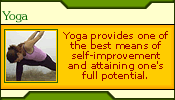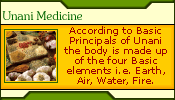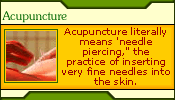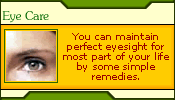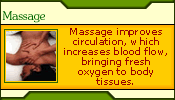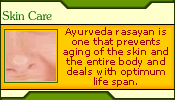|
1. Shavasana ( Dead body pose ) :
Lie flat on your back, feet comfortably part, arms and hands extended
about six inches from the body, palms upwards and fingers half-folded.
Close your eyes. Begin by consciously and gradually relaxing every
part and each muscle of the body ; feet, legs, calves, knees, thighs,
abdomen, hips, back, hands, arms, chest,shoulders, neck, head and
face. Relax yourself completely feeling as if your whole body is
lifeless. Now concentrate your mind on breathing rhythmically as
slowly and effortlessly as possible. This creates a state of complete
relaxation. Remain motionless in this position, relinquishing all
responsibilities and worries for 10 to 15 minutes. Discontinue the
exercise when your legs grow numb.
This asana helps bring down high blood pressure, and relieves the
mind, particularly for those who are engaged in excessive mental
activity. This exercise should be done both at the beginning and
at the end of the daily round of yogic asanas. During a fast, shavasana
soothes the nervous system.
2. Padmasana ( Lotus pose ) :
Sit erect and stretch your legs out in front of you. Bend one leg
to place the foot on the thigh of the other, the sole facing upwards.
Similarly, bend the other leg too, so that the heels are opposite
each other and placed in such a way that they press down on the
other side of the groin. Keep your neck, head and spine straight.
Place your palms one upon the other, both turned upward and cupped,
and rest them on the upturned heels a little below the navel.
Padmasana is a good pose for doing pranayama and meditation. It
helps in the treatment of many heart and lung diseases and digestive
disorders. It also calms and refreshes the mind.
3. Yogamudra :
Sit erect in padmasana. Fold your hands behind your back, holding
your left wrist with the right hand. Take a deep breath. While exhaling,
bend forward slowly keeping your hands on your back. Bring your
face downwards until your nose and forehead touch the floor. While
inhaling , slowly rise back to the upright position. The practice
of this asana tones up the nervous system, builds up powerful abdominal
muscles and strengthens the pelvic organs. It helps pep up digestion,
boosts the appetite and removes constipation. It tones up and relaxes
the nerves of the head and face. It also strengthens the sex glands.
4. Vajrasana ( Pelvic pose ) :
Sit erect and stretch out your legs. Fold your legs back, placing
the feet on the sides of the buttocks with the soles facing back
and upwards. Rest your buttocks on the floor between your heels.
The toes of both feet should touch. Now, place your hands on your
knees and keep the spine, neck and head straight. Vajrasana can
be performed even after meals. It improves the digestion and is
beneficial in cases of dyspepsia, constipation, colitis, seminal
weakness and stiffness of the legs. It strengthens the hips, thighs,
knees, calves, ankles and toes.
5. Shirshasana ( Topsyturvy pose ) :
Shirsha means ' head ' . In this asana, one stands on one's head.
Kneel on the ground, interlocking the fingers of both hands. Place
the ' fingerlock ' on the ground in front of you, keeping the elbows
apart. Support your head on the fingerlock. Start raising your knees
one at a time, to chest level. Then raise your feet slowly so that
the calf muscles touch the thighs. Breathe normally. This is the
first stage which should be done perfectly as the balance of the
final posture depends mainly on this stage. Next, raise your knees
first and then slowly raise the feet so that the whole body is straight,
like a pillar. This is the final pose. Return to the original position
by reversing the order, step by step. This asana should not be done
jerkily. The important factor in shirshasana is mastering the balance,
which comes through gradual practice. For proper balance, elbows
should be placed firmly on the ground, alongside the fingerlock.
Initially the asana should be done for 60 seconds only. The duration
may be gradually increased by a further 10 seconds each week.
Regular practice of shirshasana will benefit the nervous, circulatory,
respiratory, digestive, excretory and endocrine systems. This asana
helps cases of dyspepsia, seminal weakness, varicose veins, arteriosclerosis,
jaundice, renal colic and congested liver. Those suffering from
oozing from the ears, iritis, high blood pressure or a weak heart
should not practice this asana.
6. Viparitakarani ( Inverted action pose
) :
Lie flat on your back, with your feet together and arms by your
side. Press your palms down, raising your legs to a perpendicular
position without bending the knees. Your palms should touch the
waist. Then straighten your legs. The trunk should not make a right
angle with the ground but simply an upward slanting position. The
chest should not press against the chin but be kept a little away.
To return to the ground, bring your legs down slowly, evenly balancing
your weight.
Through this asana, the muscles of the neck become stronger and
blood circulation is improved. The functioning of the cervical nerves,
ganglia and the thyroid also gets improved.
7. Sarvagasana ( Shoulder stand pose ) :
In Sanskrit 'sarva' means whole and 'anga' means limb. Almost all
parts of the body are involved in and benefit from this asana. Lie
flat on your back with your arms by the side, palms turned down.
Bring your legs up slowly to a 90 o angle and then raise the rest
of the body by pushing the legs up and resting their raise the rest
of the body by pushing the legs up and resting their weight on the
arms. Fix your chin in jugular notch, and use your arms and hands
to support the body at the hip region. The weight of the body should
rest on your head, back and shoulders, your arms being used merely
for balance. The trunk and legs should be in a straight line. The
body, legs , hips and trunk should be kept as vertical as possible.
Focus your eyes on your big toes. Press your chin against your chest.
Hold the pose for one to three minutes. Return to the starting position
slowly reversing the procedure.
Sarvangasana helps relieve bronchitis, dyspepsia, varicose veins
and peps up the digestion. It stimulates the thyroid and para-thyroid
glands, influences the bran, heart and lungs. It helps lymphatic
juices to circulate in the brain and strengthens the mind. This
asana should not be done by those suffering Viparitkarani from high
blood pressure, heart disease and eye trouble.
8. Matsyasana (Fish pose ) :
Sit in padmasana. Bend backwards and lie flat on your back without
raising your knees. Press your palms beneath the shoulder. Push
the hip backwards thus making a bridge -like arch with the spine.
Then making hooks of your forefingers, grasp your toes without crossing
your arms. Maintain this pose and breathe rhythmically and comfortably.
Reverse the order and return gradually to the starting position
of Padamasana. Matsyasana is beneficial in the treatment of acidity,
constipation, diabetes, asthma, bronchitis and other lung disorders.
9. Uttanapadasana ( Left-lifting pose) :
Lie on your back with leg and arms straight, feet together, palms
facing downwards, on the floor close to the body. Raise your legs
above two feet from the floor without bending your knees. Maintain
this pose for some time. Then, lower your legs slowly without bending
the knees. This asana is helpful for those suffering from constipation.
It strengthens the abdominal muscles and intestinal organs.
10. Halasana ( Plough pose ) :
Lie flat on your back with legs and feet together, arms by your
side with fists closed near your thigh keeping your legs straight,
slowly raise them to angles of 300, 600 and 900, pausing slightly
at each point. Gradually, raise your legs above your head without
bending your knees and then move them behind until they touch the
floor. Stretch your legs as far as possible so that your chin presses
tightly against the chest while your arms remain on the floor as
in the original position. Hold the pose from between 10 seconds
to three minutes, breathing normally. To return to the starting
position slowly reverse the procedure.
This asana relieves tension in the back, neck, and legs and is
beneficial in the treatment of lumbago, spinal rigidity and rheumatism,
myalgia, arthritis, sciatics and asthma.
|


